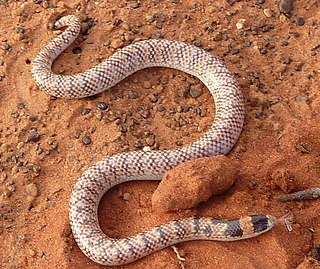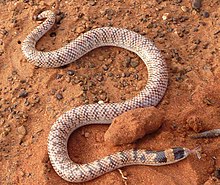
The eastern brown snake, often referred to as the common brown snake, is a species of highly venomous snake in the family Elapidae. The species is native to eastern and central Australia and southern New Guinea. It was first described by André Marie Constant Duméril, Gabriel Bibron, and Auguste Duméril in 1854. The adult eastern brown snake has a slender build and can grow to 2 m (7 ft) in length. The colour of its surface ranges from pale brown to black, while its underside is pale cream-yellow, often with orange or grey splotches. The eastern brown snake is found in most habitats except dense forests, often in farmland and on the outskirts of urban areas, as such places are populated by its main prey, the house mouse. The species is oviparous. The International Union for Conservation of Nature classifies the snake as a least-concern species, though its status in New Guinea is unclear.

The woma python, also known commonly as Ramsay's python, the sand python, and simply the woma, is a species of snake in the family Pythonidae, endemic to Australia. Once common throughout Western Australia, it has become critically endangered in some regions.

Pseudonaja is a genus of highly venomous elapid snakes native to Australia. Species of this genus are known commonly as brown snakes and are considered to be some of the most dangerous snakes in the world; even young snakes are capable of delivering a fatal envenomation to a human.

Cacophis is a genus of venomous snakes, commonly known as crowned snakes, in the family Elapidae. The genus is endemic to Australia.

The king brown snake is a species of highly venomous snake of the family Elapidae, native to northern, western, and Central Australia. Despite its common name, it is a member of the genus Pseudechis and only distantly related to true brown snakes. Its alternative common name is the mulga snake, although it lives in many habitats apart from mulga. First described by English zoologist John Edward Gray in 1842, it is a robust snake up to 3.3 m (11 ft) long. It is variable in appearance, with individuals from northern Australia having tan upper parts, while those from southern Australia are dark brown to blackish. Sometimes, it is seen in a reddish-green texture. The dorsal scales are two-toned, sometimes giving the snake a patterned appearance. Its underside is cream or white, often with orange splotches. The species is oviparous. The snake is considered to be a least-concern species according to the International Union for Conservation of Nature, though may have declined with the spread of the cane toad.

Simoselaps, or Australian coral snakes, is a genus composed of 12 species of venomous elapid snakes.

Suta is a genus of venomous snakes in the family Elapidae. The genus is endemic to mainland Australia.
This article lists the various snakes of Australia which live in a wide variety of habitats around the country. The amethystine python or scrub python is considered Australia's largest native snake.

Cryptoblepharus australis, commonly called the inland snake-eyed skink, is a species of skink in the genus Cryptoblepharus.
Cacophis krefftii is a species of venomous snake in the family Elapidae. The species is endemic to Australia.

The excitable delma is a species of lizard in the Pygopodidae family endemic to Australia. The lizard gets its name from its active and jumpy defense mechanism. It will erratically jump multiple times in succession, each jump pivoting its body in a different direction. The D. tincta is a slender, long legless lizard that through evolution lost its limbs. It is found throughout Australia in a variety of habitats, and spends most of its time hiding. Due to its nocturnal nature, it is rare to spot in the wild. This legless lizard is small to moderate in size, with a tail that is three to four times its body length. The typical size of the excitable delma is 250 – 300 mm. This lizard is an insectivore and feeds on insects it finds when travelling through grass, logs, surface soil, and loose rocks. Like all pygopodids, the excitable delma is oviparous and only lays two eggs per clutch.

Brachyurophis fasciolatus is a species of snake from the family Elapidae, commonly named the narrow-banded shovel-nosed snake, or narrow-banded burrowing snake, and is a species endemic to Australia. Its common names reflect its shovel nose specialization, burrowing behaviour and banded body colour.
Brachyurophis incinctus is a species of snake from the family Elapidae, commonly named the unbanded shovel-nosed snake, and is a species endemic to Australia. Its common name reflects its shovel nose specialisation, burrowing behaviour and the fact that it is not banded on its body.

Brachyurophis australis(coral snake) is a species of snake from the family Elapidae and is a species endemic to Australia. Its common name reflects its shovel nose specialisation.
Brachyurophis approximans, also known as the north-western shovel-nosed snake, is a species of venomous burrowing snake that is endemic to Australia. The specific epithet approximans (“approaching”) alludes to its similarity to Brachyurophis campbelli.
Brachyurophis campbelli, also known as the Cape York shovel-nosed snake or Einasliegh shovel-nosed snake, is a species of venomous burrowing snake that is endemic to Australia. The specific epithet campbelli honours a Mr W.D. Campbell who collected the type specimen in 1928 in the vicinity of Almaden, Queensland.
Brachyurophis roperi, also known as the northern shovel-nosed snake, is a species of venomous burrowing snake that is endemic to Australia. The specific epithet roperi refers to the type locality of the Roper River Mission in the Northern Territory. It was formerly considered a subspecies of Brachyurophis semifasciatus.
Brachyurophis morrisi, also known as the Arnhem shovel-nosed snake, is a species of venomous burrowing snake that is endemic to Australia. The specific epithet morrisi honours author and naturalist Ian James Morris for his contributions to knowledge of the animals of the Northern Territory, who first collected the species in 1970.










